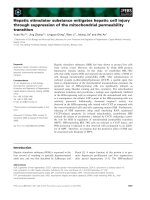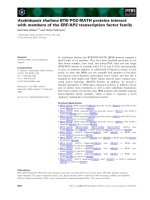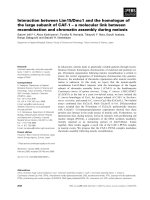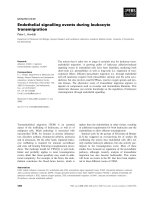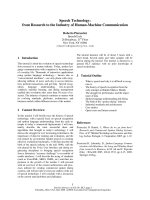Báo cáo khoa học: "Information technology issues during and after Katrina and usefulness of the Internet: how we mobilized and utilized digital communications systems" docx
Bạn đang xem bản rút gọn của tài liệu. Xem và tải ngay bản đầy đủ của tài liệu tại đây (36.6 KB, 3 trang )
Page 1 of 3
(page number not for citation purposes)
FEMA = Federal Emergency Management Agency; GIS = geoinformation system; GPS = global positioning system; UAV = unmanned aerial
vehicle.
Available online />Abstract
Even more than in previous disasters, Katrina has proven itself to
be a testing ground for a plethora of new technologies. Although
not all of these technologies did immediately save lives, in this
regard a number of them exhibited considerable potential for the
future, and hence there is a need to include them in future
contingency plans. However, a need for change in the modes and
patterns of technology deployment to maximize their leverage has
also become very clear.
In the immediate aftermath of a catastrophic disruption,
communication channels break down and must be re-
established as rapidly as possible so that emergencies may
be reported and first response team efforts coordinated in the
field. Cell towers are typically not equipped with sufficient
emergency power backup capacities, and backup generators
of long-distance switches do not tolerate flooding. As a
result, both mobile phone and long-distance phone terrestrial
communication suffered an almost complete disruption in
Katrina’s wake. Over 60% of networks were still down 3
weeks after the event [1].
In comparison, satellite communications remained
quantitatively operational and were utilized within minutes of
the disaster by FEMA, the National Guard and the Red
Cross, as well as by state and local first responders, utility
workers, and people in search of relatives. More than 20,000
Globalstar, Iridium and Mobile Satellite Ventures satellite
phones and terminals were deployed in the affected region
within 2 days after the event. Within the first 72 hours the
Iridium network traffic surged by 3000%, and the subscriber
base rose by 500%. The provider Globalstar was activating
1400 devices/day, as compared with a typical rate of about
80 devices/day. Mobile Satellite Ventures reported an
increase in traffic in the affected region of more than 400%,
and supplied satellite terminals to a number of emergency
responders (e.g. FEMA’s Urban Search and Rescue teams).
Given these recent experiences, the Satellite Industry
Association strongly suggested that in future satellite
communications must be made an essential part of future
critical communication networks; that satellite capacity and
equipment must be pre-purchased and pre-positioned, with
operator training included; and that satellite operators and
personnel must be credentialed as first responders so that
they may be admitted to restricted areas [2]. In some cases,
however, poor planning (e.g. lack of SIM cards for devices
shipped) rendered satellite phones useless [3]. As usual,
amateur radio operators (hams) were highly useful in
providing decentralized emergency communication services,
both for voice and data (packet radio), especially where
power was absent and other means of communication
unavailable [4,5].
Wireless networks have already played an important role in
disasters before Katrina. Today, reliable voice (i.e. VoIP [voice
over Internet protocol]), video, and data services (including
medical telemetry and control) can easily coexist, even on
relatively low-bandwidth links, provided that compression and
quality of service for latency-critical signals is supported by
the protocol and the end devices. Recent advances in
technology have enabled new transmission standards
(satellite data, wired, microwave, WiMax for Wide Area
Network connections, and WiFi for the local device
communication cloud) to debut in the field. This enabled
small operators and teams of volunteers to deploy ad hoc
networks. Mesh radio, a self-organizing failure-tolerant
wireless network, was first seen in the wild [6]. Multiple
corporations, using their enterprise infrastructure, have
donated free connectivity and terminals [7].
Commentary
Information technology issues during and after Katrina and
usefulness of the Internet: how we mobilized and utilized digital
communications systems
Eugen Leitl
AtiVel Ltd., Unterbrunner Str. 22a, D-82131 Gauting, Germany
Corresponding author: Eugen Leitl,
Published: 14 December 2005 Critical Care 2006, 10:110 (doi:10.1186/cc3945)
This article is online at />© 2005 BioMed Central Ltd
Page 2 of 3
(page number not for citation purposes)
Critical Care Vol 10 No 1 Leitl
As general awareness is growing that Internet-based (i.e.
utilizing TCP/IP [transmission control protocol/Internet protocol]
protocol suite) communication is to become a vital part of the
nation’s emergency response system [8], the Renesys report
on Katrina’s impact on the Internet infrastructure [9] indicates
that the backbone network and emergency power
infrastructure in the chronically hurricane-afflicted area is not
sufficiently redundant to become a reliable backbone of
services, especially locally and in the last mile. At peak
disruption, more than 35% networks suffered an outage, and
recovery over the course of the next days was slow. Internet2,
a poorly redundant (single-provider fiber) next generation
research network, was completely unavailable.
Some spontaneous self-organization up from the grassroots
has caused volunteer driven geoinformation system (GIS)
efforts such as Telascience [10] to spring up across the
Internet. US National Oceanic and Atmospheric Adminis-
tration provided the initial core of 1500 high-resolution digital
aerial images, which two initial collaborators turned into a
usable prototype, with open source tools, within half a day,
using internet relay chat (IRC) and instant messaging (IM) for
developer coordination. A number of other spontaneous
contributors from government, academia and research, and
open source developers (including members from the
National Geospatial-Intelligence Agency [11], National
Reconnaissance Office [12], US Geological Survey [13], and
US Naval Research Laboratory [14]) donated resources and
joined the project, which grew in size, eventually causing new
missions to be flown, and came to contain 5000 fully
mosaicked and geocoded images as well as different types of
data sets [15].
Other volunteers have provided a Katrina data add-on
(recently generalized into a generic hurricane package called
the 2005 Hurricane Add-on [16]) for the already quite
popular NASA World Wind project [17] – a set of online
servers and fully interactive, real-time, three-dimensional open
source Earth browser. It is remarkable that this small band of
amateurs, with no large corporation or government body
behind them, has produced far more imagery and better geo-
referenced data than the much heavier funded and far more
strongly backed Google Earth’s Katrina offering [18].
In a very effective application of a GIS system, the Mid-
American Geospatial Information Centre helped to rescue
more than 25,000 survivors by using a GIS system to match
9-1-1 calls from mobile phone calls in New Orleans hours
after Katrina to GPS coordinates and street addresses on
emergency switchboards in real time. Rescue teams in the
field with mobile computers connected to The University of
Texas at Austin’s Centre for Space Research by a data link
via satellite were guided to the location using global
positioning system (GPS) coordinates and satellite imagery.
Mid-American Geospatial Information Centre also provided
flood depth estimation (using preflood terrain elevation data
and post-landfall satellite imagery), and based upon it
suggested an appropriate choice of rescue vehicle.
Autonomous military aircraft and tele-operated robotic
platforms [19], which have been designed to scan large areas
of typically inaccessible terrain looking for human life signatures
[20] for prolonged periods, in any weather, with one or many
devices for each human operator, are an almost perfect match
for finding survivors [21]. Post-Katrina New Orleans has seen
the largest yet civilian mission deployment of military unmanned
aerial vehicles (UAVs). The Evolution is a lightweight craft, at
6.5 pounds, and it has a range of 10 km. Typically operating at
a height of about 300 feet, it is powered by lithium batteries
and can cruise for 1–2 hours, depending on mission type.
Controlled remotely from a portable computer, it can fly
autonomously with a GPS autopilot, can be launched within
15 min after unpacking, and remotely relays color video and
low-light TV or passive infrared camera imagery to its operator.
Ten Evolution UAVs were flown from the New Orleans Naval
Air Station to assess structure damage and flooding data. The
heavier but still hand-launched or catapult-launched Silver Fox
weighs 22 pounds, is powered by a gasoline motor, and has a
range of 240 km, at typically 300 m operational altitude. It can
stay aloft for 10 hours (with an engine upgrade in planning
permitting a duration twice that long), and allows the operator
to look for survivors using a passive infrared (body-emitted,
long-wave thermal radiation) camera. Five Silver Foxes were
flown in New Orleans [22]. While saving no lives, similar
experiences were reported with two other designs of UAVs (a
fixed-wing and helicopter) searching for trapped flood survivors
in Mississippi by the University of South Florida and the Centre
for Robot-Assisted Search and Rescue [23].
As expected, web services (a term for an industry-standard
based set of wire protocols and XML syntax) useful for
automatically integrating diverse real-time feeds from
government and private data such as weather radar, web
applications, and classical media such as blogs [24], wikis
[25], and web forums for end users and medical
professionals [26] sprang up rapidly and have seen
considerable use. The volunteer-based PeopleFinder project
[27], for example, integrated more than 100,000 missing
person and evacuee records within 5 days.
In summary, most of the discussed applications of information
technology during the immediate Katrina aftermath were on
too small a scale and were insufficiently preplanned to have a
major impact in the field. New technologies emerge
continuously, however, and must be proactively planned for in
future deployment scenarios. Infrastructure must be
prestocked and personnel pretrained; in some cases the
military or civilian technology needs adaptation for use in a
first response emergency theatre.
Competing interests
The author(s) declare that they have no competing interests.
Page 3 of 3
(page number not for citation purposes)
References
1. Networkingpipeline [ />jhtml?articleID=170702829]
2. Written statement of Tony Trujillo, Chairman, Satellite Industry
Association [ />SIA%20Written%20Testimony%20for%209-29-05.pdf]
3. Boingboing
[ />4. Krakow G: Ham radio operators to the rescue after Katrina
[ />5. ARRL President Jim Haynie’s testimony submitted to the
House Government Reform Committee [ />news/stories/2005/09/15/100/#statement]
6. Jeblog [ />7. RadioShack offers free internet access to Hurricane Katrina
victims [ />8. Mark R: FCC: IP vital for emergency communications
[ />9. Cowie J, Popescu A, Underwood T: Impact of Hurricane Katrina
on Internet infrastructure [ />Renesys-Katrina-Report-9sep2005.pdf]
10. []
11. National Geospatial-Intelligence Agency [ />12. National Reconnaissance Office [www.nro.gov/]
13. US Geological Survey [ />14. US Naval Research Laboratory [ />15. Mitchell T: Katrina maps and photos via open source tools
[ />16. Add-on: 2005 Hurricane Imagery Add-On [ld-
windcentral.com/wiki/Add-on:2005_Hurricane_Imagery_Add-On]
17. Learning technologies: World Wind 1.3 [.
nasa.gov/]
18. Global Connection [ />19. Walton M: Robots can be lifesaving rescue workers
[ />20. Boyle A: How high-tech is coming to the rescue
[ />21. Gussow D: Robot rescue: these guys go where human
searchers can’t [ />Robot_rescue__These_g.shtml]
22. Mohney D: UAVs over New Orleans [ategypage.
com/dls/articles/2005910101827.asp]
23. USF deploys unmanned aerial vehicles to Katrina rescue
operation [ />050908081119.htm]
24. Thomas CB: New Orleans Today: it’s worse than you think
(Time) [ />25. KatrinaHelp [o/wiki/index.php/Main_Page]
26. KatrinaHealth [ />27. Katrina PeopleFinder Launched [ />Article.aspx?a=13483&hed=Katrina+PeopleFinder+Launched]
Available online />
